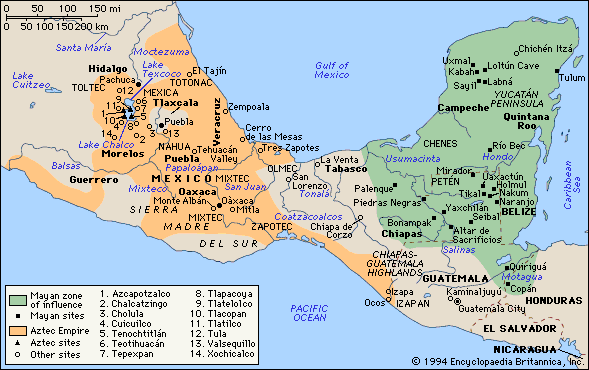

The first signs of complex society in Mesoamerica were the Olmecs an ancient Pre-Columbian civilization living in the tropical lowlands of south-central Mexico, in what are roughly the modern-day states of Veracruz and Tabasco.
The area is about 125 miles long and 50 miles wide (200 by 80 km), with the Coatzalcoalcos River system running through the middle. These sites include San Lorenzo Tenochtitlan, Laguna de los Cerros, Tres Zapotes, and La Venta, one of the greatest of the Olmec sites. La Venta is dated to between 1200 BCE through 400 BCE which places the major development of the city in the Middle Formative Period. Located on an island in a coastal swamp overlooking the then-active Rio Palma river, the city of La Venta probably controlled a region between the Mezcalapa and Coatzacoalcos rivers.
The Olmec domain extended from the Tuxtlas mountains in the west to the lowlands of the Chontalpa in the east, a region with significant variations in geology and ecology. Over 170 Olmec monuments have been found within the area, and eighty percent of those occur at the three largest Olmec centers, La Venta, Tabasco (38%), San Lorenzo Tenochtitlan, Veracruz (30%), and Laguna de los Cerros, Veracruz (12%).
Those three major Olmec centers are spaced from east to west across the domain so that each center could exploit, control, and provide a distinct set of natural resources valuable to the overall Olmec economy. La Venta, the eastern center, is near the rich estuaries of the coast, and also could have provided cacao, rubber, and salt. San Lorenzo, at the center of the Olmec domain, controlled the vast flood plain area of Coatzacoalcos basin and riverline trade routes.
Laguna de los Cerros, adjacent to the Tuxtlas mountains, is positioned near important sources of basalt, a stone needed to manufacture manos, metates, and monuments. Perhaps marriage alliances between Olmec centers helped maintain such an exchange network.
The Olmec heartland is an archaeological term used to describe an area in the Gulf lowlands that is generally considered the birthplace of the Olmec culture. This area is characterized by swampy lowlands punctuated by low hills, ridges, and volcanoes. The Tuxtlas Mountains rise sharply in the north, along the Gulf of Mexico's Bay of Campeche. Here the Olmecs constructed permanent city-temple complexes at San Lorenzo Tenochtitlan, La Venta, Tres Zapotes, and Laguna de los Cerros. In this region, the first Mesoamerican civilization would emerge and reign from 1400-400 BCE.
The Olmec flourished during Mesoamerica's Formative period, dating roughly from 1400 BCE to about 400 BCE. As the first Mesoamerican civilization, they laid much of the foundation for the civilizations that would follow. Their influence went beyond the heartland - from Chalcatzingo, far to the west in the highlands of Mexico, to Izapa, on the Pacific coast near what is now Guatemala, Olmec goods have been found throughout Mesoamerica during this period.
What we today call Olmec first appears within the city of San Lorenzo Tenochtitlan, where distinctive Olmec features appear around 1400 BCE. The rise of civilization here was assisted by the local ecology of well-watered alluvial soil, as well as by the transportation network that the Coatzacoalcos river basin provided.
This environment may be compared to that of other ancient centers of civilization: the Nile, Indus, and Yellow River valleys, and Mesopotamia. This highly productive environment encouraged a dense concentrated population which in turn triggered the rise of an elite class.
It was this elite class that provided the social basis for the production of the symbolic and sophisticated luxury artifacts that define Olmec culture. Many of these luxury artifacts, such as jade, obsidian and magnetite, came from distant locations and suggest that early Olmec elites had access to an extensive trading network in Mesoamerica. The source of the most valued jade, for example, is found in the Motagua River valley in eastern Guatemala, and Olmec obsidian has been traced to sources in the Guatemala highlands, such as El Chayal and San Martin Jilotepeque, or in Puebla, distances ranging from 200 to 400 km away (120 - 250 miles away) respectively.
The first Olmec center, San Lorenzo, was all but abandoned around 900 BCE at about the same time that La Venta rose to prominence. A wholesale destruction of many San Lorenzo monuments also occurred circa 950 BCE, which may point to an internal uprising or, less likely, an invasion. The latest thinking, however, is that environmental changes may have been responsible for this shift in Olmec centers, with certain important rivers changing course.
Following the decline of San Lorenzo, La Venta became the most prominent Olmec center, lasting from 900 BCE until its abandonment around 400 BCE. La Venta sustained the Olmec cultural traditions, but with spectacular displays of power and wealth. The Great Pyramid was the largest Mesoamerican structure of its time. Even today, after 2500 years of erosion, it rises 34 meters above the naturally flat landscape. Buried deep within La Venta, lay opulent, labor-intensive "Offerings": 1000 tons of smooth serpentine blocks, large mosaic pavements, and at least 48 separate deposits of polished jade celts, pottery, figurines, and hematite mirrors.
It is not known with any clarity what caused the eventual extinction of the Olmec culture. It is known that between 400 and 350 BCE, population in the eastern half of the Olmec heartland dropped precipitously, and the area would remain sparsely inhabited until the 19th century.
This depopulation was likely the result of "very serious environmental changes that rendered the region unsuited for large groups of farmers", in particular changes to the riverine environment that the Olmec depended upon for agriculture, for hunting and gathering, and for transportation. Archaeologists propose that these changes were triggered by tectonic upheavals or subsidence, or the silting up of rivers due to agricultural practices.
One theory for the considerable population drop during the Terminal Formative period is suggested by Santley and colleagues (Santley et al. 1997) and proposes shifts in settlement relocation due to volcanism instead of extinction. Volcanic eruptions during the Early, Late and Terminal Formative periods would have blanketed the lands and forced the Olmecs to move their settlements.
Whatever the cause, within a few hundred years of the abandonment of the last Olmec cities, successor cultures had become firmly established. The Tres Zapotes site, on the western edge of the Olmec heartland, continued to be occupied well past 400 BCE, but without the hallmarks of the Olmec culture. This post-Olmec culture, often labeled Epi-Olmec, has features similar to those found at Izapa, some 330 miles (550 km) to the southeast.
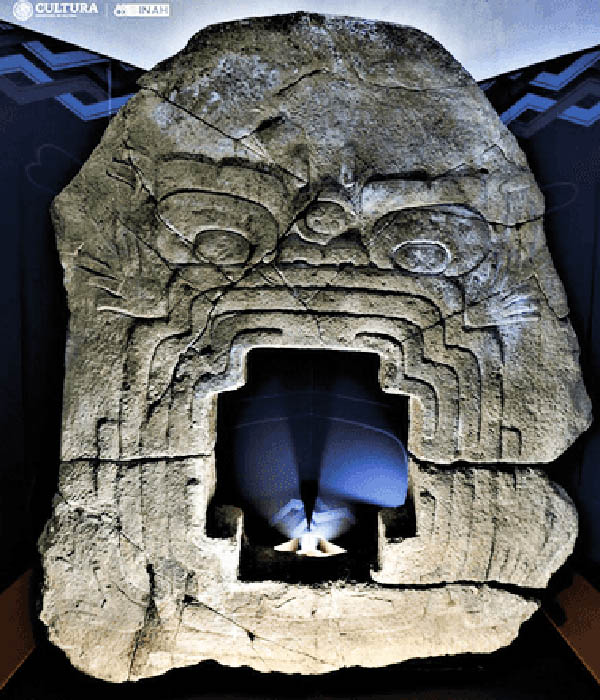
An ancient Olmec monument symbolizing the entrance to the afterlife has finally been restored to its former glory and returned to its ancestral home, almost 3,000 years after it was sculpted Live Science - June 4, 2024
An ancient Olmec monument symbolizing the entrance to the afterlife has finally been restored to its former glory and returned to its ancestral home, almost 3,000 years after it was sculpted. The enormous Portal al Inframundo (Portal to the Underworld) is thought to have been looted in the 1960s, yet was only brought back to Chalcatzingo in central Mexico following a decades-long investigation into its whereabouts.
Located in the state of Morelos, Chalcatzingo was an important Olmec site that is famous for its enormous sculpted monuments. Among these was the Portal to the Underworld, which depicts the gaping jaws of a mythical feline figure, forming an opening that represents the threshold of the spiritual realm. The piece has been dated to the Preclassic period, and is thought to have been created sometime between 800 and 400 BCE. Unfortunately, however, the monumental artwork was ransacked shortly after it was discovered in the mid-20th century.
Olmec artforms emphasize both monumental statuary and small jade carvings and jewelry. Much Olmec art is highly stylized and uses an iconography reflective of the religious meaning of the artworks. Some Olmec art, however, is surprisingly naturalistic, displaying an accuracy of depiction of human anatomy perhaps equaled in the Pre-Columbian New World only by the best Maya Classic era art.
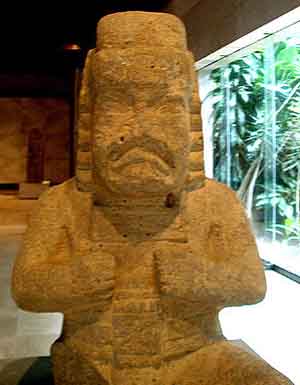
Common motifs include downturned mouths and slit-like slanting eyes, both of which can be seen in most representations of "were-jaguars" or jaquar gods. The were-jaguar motif is characterized by almond-shaped eyes, a downturned open mouth, and a cleft head. The were-jaguar supernatural incorporates the were-jaguar motif as well as other features, although various academics define the were-jaguar supernatural differently.
The most well-known aspect of shamanism in Mesoamerican religion, and in the whole of Native American shamanism, is the ability to assume the powers of animals associated with the shaman. Such animals are called nahuales, and in Olmec art the most common of these is the jaguar. In a sense, the optimal spirit would have the spirituality and intellect of man and the ferocity and strength of the jaguar, these are all combined in the shaman and his jaguar nahuale. The Jaguar Child may exemplify this combination. This is a very common representation in Olmec art, and it often includes the slitted eyes and curved mouth pronounced in this close-up.
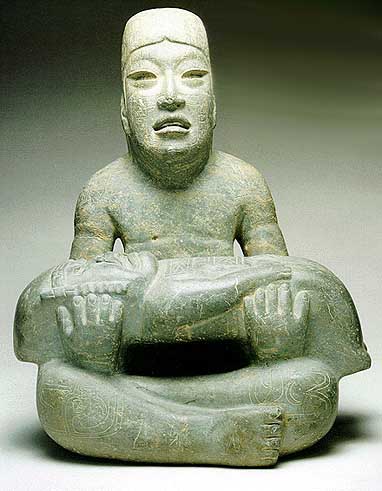
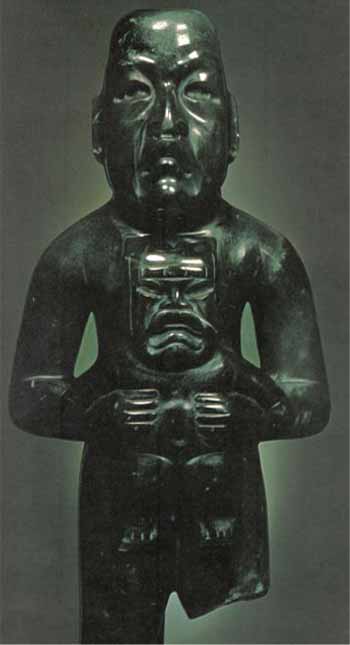
Jade figure holding jaguar baby 1150-500 BC
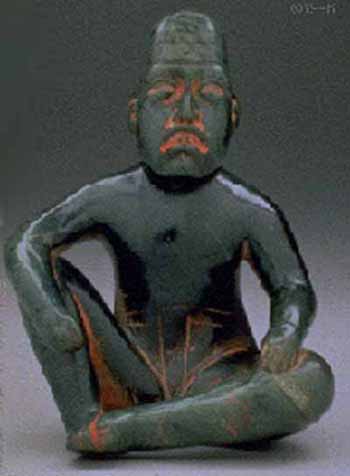
The Olmec culture was first defined as an art style, and this continues to be the hallmark of the culture. Wrought in a large number of mediums - jade, clay, basalt, and greenstone among others - much Olmec art, such as the Wrestler, is surprisingly naturalistic.
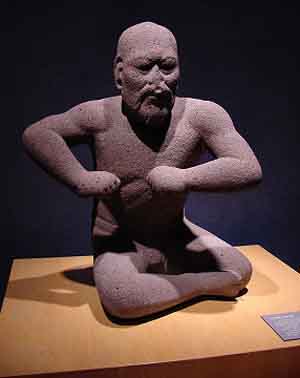
Other art, however, reveals fantastic anthropomorphic creatures, often highly stylized, using an iconography reflective of a religious meaning. Common motifs include downturned mouths and a cleft head, both of which are seen in representations of were-jaguars.
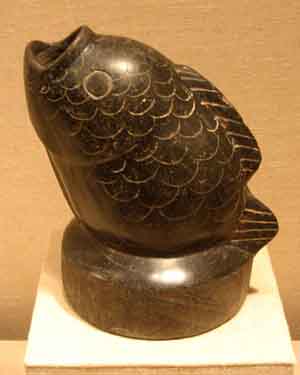
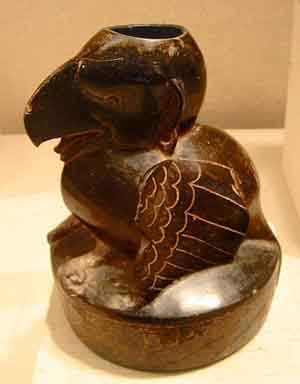
In addition to human subjects, Olmec artisans were adept at animal portrayals, for example, the ceramic ancient Olmec "Bird Vessel", and "Fish Vessel" dating to circa 1000 BC. Ceramics are produced in kilns capable of exceeding approximately 900° C. The only other prehistoric culture known to have achieved such high temperatures is that of Ancient Egypt. Bird Headed Beings.
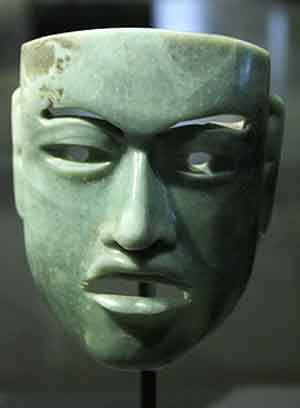
Another type of artifact is much smaller; hardstone carvings in jade of a face in a mask form. Curators and scholars refer to "Olmec-style" face masks as despite being Olmec in style, to date no example has been recovered in a archaeologically controlled Olmec context. However they have been recovered from sites of other cultures, including one deliberately deposited in the ceremonial precinct of Tenochtitlan (Mexico City), which would presumably have been about 2,000 years old when the Aztecs buried it, suggesting these were valued and collected as Roman antiquities were in Europe.
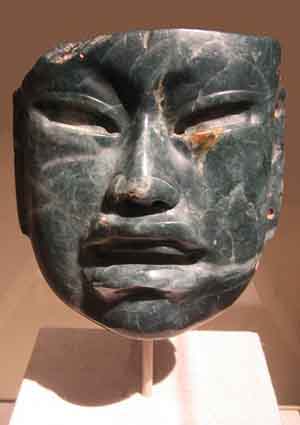
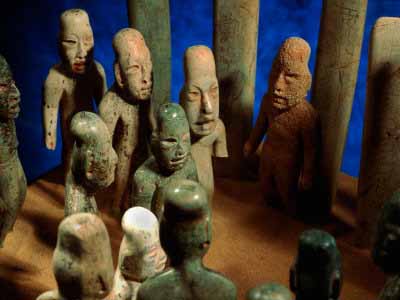
There is no definite answer for what this scene is enacting.
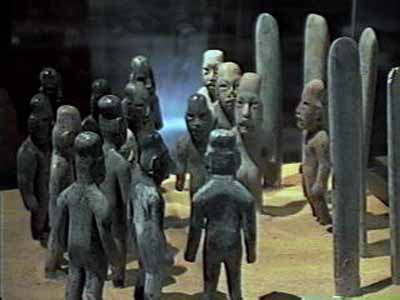
The men have elongated skulls, the result of
cranial deformation begun at an early age.
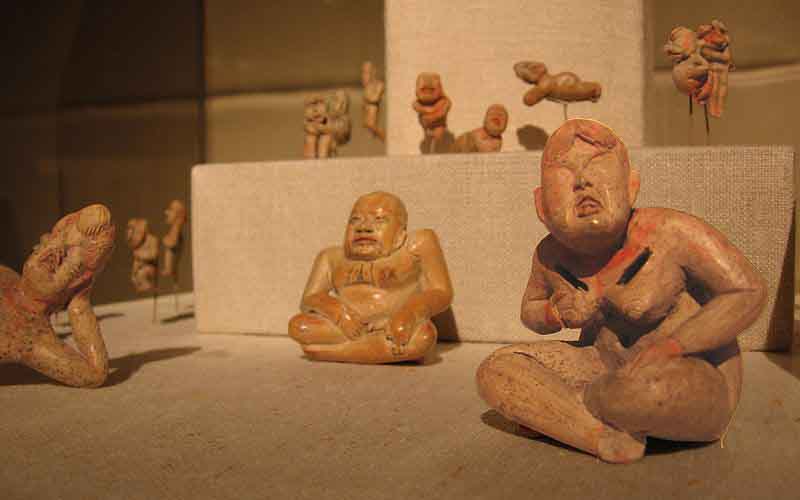
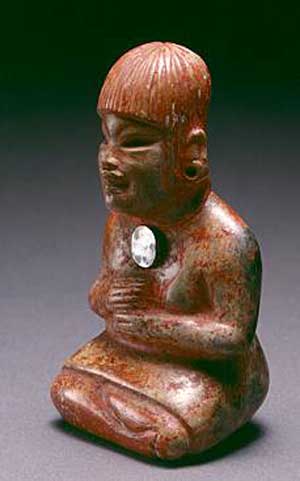
A rare depiction of a female in Olmec art, this seated figure is also unusual for her hematite mirror ornament. Her seated pose and mirror, an emblem of political and religious authority, convey her elite status. Mirrors functioned as divination tools, providing symbolic access to other realms.
This article on the Olmec figurine describes a number of archetypical figurines produced by the Formative Period inhabitants of Mesoamerica. While many of these figurines may or may not have been produced directly by the people of the Olmec heartland, they bear the hallmarks and motifs of Olmec culture.
These figurines are usually found in household refuse, in ancient construction fill, and (outside the Olmec heartland) in graves, although many Olmec-style figurines, particularly those labelled as Las Bocas- or Xochipala-style, were recovered by looters and are therefore without provenance.
The vast majority of figurines are simple in design, often nude or with a minimum of clothing, and made of local terracotta. Most of these recoveries are mere fragments: a head, arm, torso, or a leg. It is thought, based on wooden busts recovered from the water-logged El Manati site, that figurines were also carved from wood, but, if so, none have survived.
More durable and better known by the general public are those figurines carved, usually with a degree of skill, from jade, serpentine, greenstone, basalt, and other minerals and stones.
In March 2005, a team of archaeologists used NAA (neutron activation analysis) to compare over 1000 ancient Mesoamerican Olmec-style ceramic artifacts with 275 samples of clay so as to "fingerprint" pottery origination. They found that "the Olmec packaged and exported their beliefs throughout the region in the form of specialized ceramic designs and forms, which quickly became hallmarks of elite status in various regions of ancient Mexico.
In August 2005 another study, this time using petrography, found that the "exchanges of vessels between highland and lowland chiefly centers were reciprocal, or two way." Five of the samples dug up in San Lorenzo were "unambiguously" from Oaxaca. According to one of the archaeologists conducting the study, this "contradicts recent claims that the Gulf Coast was the sole source of pottery" in Mesoamerica.
The results of the INAA study were later defended in March 2006 in two articles in Latin American Antiquity. Because the INAA sample is much larger than the petrographic sample (a total of over 1600 analyses of raw materials and clays vs. approximately 20 pottery thin sections in the petrographic study), the authors of the Latin American Antiquity papers argue that the petrographic study cannot possibly overturn the INAA study.
While Olmec figurines are found abundantly in sites throughout the Formative Period, it is the stone monuments such as the colossal heads that are the most recognizable feature of Olmec culture. These monuments can be divided into four classes:
Colossal heads
Rectangular "altars" (more likely thrones)
Free-standing in-the-round sculpture, such as the twins from El Azuzul or San Martin Pajapan Monument 1.
Stelae, such as La Venta Monument 19 above. The stelae form was generally introduced later than the colossal heads, altars, or free-standing sculptures. Over time stelae moved from simple representation of figures, such as Monument 19 or La Venta Stela 1, toward representations of historical events, particularly acts legitimizing rulers. This trend would culminate in post-Olmec monuments such as La Mojarra Stela 1, which combines images of rulers with script and calendar dates.
The most recognized aspect of the Olmec civilization are the enormous helmeted heads. As no known pre-Columbian text explains them, these impressive monuments have been the subject of much speculation. Once theorized to be ballplayers, it is now generally accepted that these heads are portraits of rulers, perhaps dressed as ballplayers. Infused with individuality, no two heads are alike and the helmet-like headdresses are adorned with distinctive elements, suggesting to some personal or group symbols.
In 1939 a carving was discovered near the gigantic head with a characteristic Olmec design on one side and a date symbol on the other. This revealed a shocking truth: the Olmecs had a far greater right to be considered the mother culture. Hundreds of years earlier than anyone had imagined, simple villages had given way to a complex society governed by kings and priests, with impressive ceremonial centers and artworks. Today many find the term "mother culture" misleading, but clearly the Olmecs came first.
Other megalithic heads were discovered in the intervening years, all with African facial features. This is not necessarily to suggest that the founders or leaders of Olmec civilization came directly from Africa, since many original populations of countries like Cambodia and the Philippines have similar characteristics. These might have been brought along when the first humans entered the Americas from Asia.
Many Olmec heads had the symbol of the jaguar in different headpieces. The jaguar is a potent symbol that represents the Mesoamerican cultures. The olmec used the shaman during a sacred ritual to transform into a jaguar. They believe that the jaguar was the living and the dead. Also they thought the olmec clearly imaged that their shamans transformed on ritual occasions into a perfect structure that was very important to them. They thought that was important for the gods, ritual, and myths.
| Site | Count | Designations |
|---|---|---|
| San Lorenzo | 10 | Colossal Heads 1 through 10 |
| La Venta | 4 | Monuments 1 through 4 |
| Tres Zapotes | 2 | Monuments A & Q |
| Rancho la Cobata | 1 | Monument 1 |
The heads range in size from the Rancho La Cobata head, at 3.4 m high, to the pair at Tres Zapotes, at 1.47 m. It has been calculated that the largest heads weigh between 25 and 55 short tons (50 t).
The heads were carved from single blocks or boulders of volcanic basalt, found in the Tuxtlas Mountains. The Tres Zapotes heads, for example, were sculpted from basalt found at the summit of Cerro el Vigia, at the western end of the Tuxtlas. The San Lorenzo and La Venta heads, on the other hand, were likely carved from the basalt of Cerro Cintepec, on the southeastern side, perhaps at the nearby Llano del Jicaro workshop, and dragged or floated to their final destination dozens of miles away. It has been estimated that moving a colossal head required the efforts of 1,500 people for three to four months.
Some of the heads, and many other monuments, have been variously mutilated, buried and disinterred, reset in new locations and/or reburied. It is known that some monuments, and at least two heads, were recycled or recarved, but it is not known whether this was simply due to the scarcity of stone or whether these actions had ritual or other connotations. It is also suspected that some mutilation had significance beyond mere destruction, but some scholars still do not rule out internal conflicts or, less likely, invasion as a factor.
Almost all of these colossal heads bear the same features, flattened nose, wide lips, and capping headpiece, possible features of the Olmec warrior-kings. These characteristics have caused some debate due to their apparent resemblance to African facial characteristics. Based on this comparison, some have insisted that the Olmecs were Africans who had emigrated to the New World. However, claims of pre-Columbian contacts with Africa are rejected by the vast majority of archeologists and other Mesoamerican scholars.
Explanations for the facial features of the colossal heads include the possibility that the heads were carved in this manner due to the shallow space allowed on the basalt boulders. Others note that in addition to the broad noses and thick lips, the heads have the Asian eye-fold, and that all these characteristics can still be found in modern Mesoamerican Indians. To support this, in the 1940s artist/art historian Miguel Covarrubias published a series of photos of Olmec artworks and of the faces of modern Mexican Indians with very similar facial characteristics. In addition, the African origin hypothesis assumes that Olmec carving was intended to be realistic, an assumption that is hard to justify given the full corpus of representation in Olmec carving.
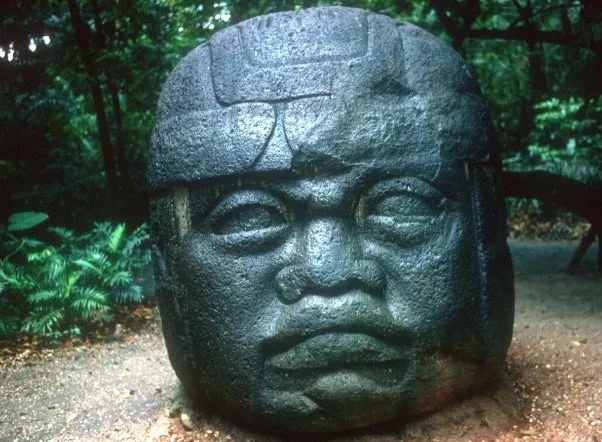
Ancient Artifacts Of Guatemala Have A Powerful Magnetic Field
Twin 'grumpy mouth' reliefs of Olmec contortionists discovered in Mexico
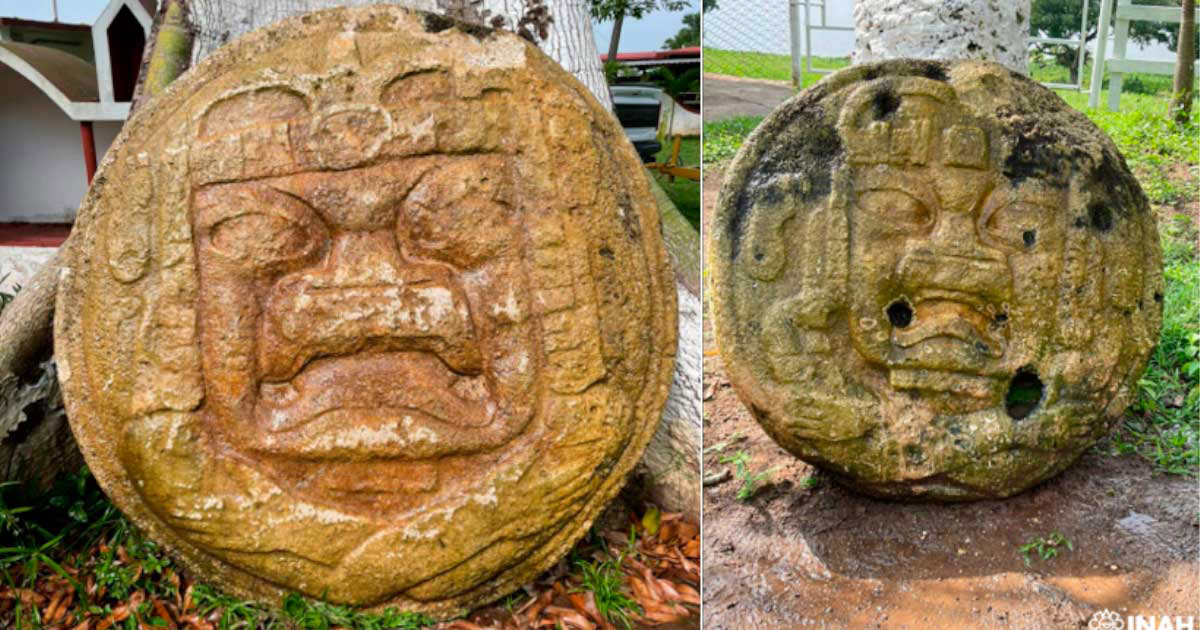
Two Huge Stone Olmec Reliefs Depict Rulers in Divine Trance Pose
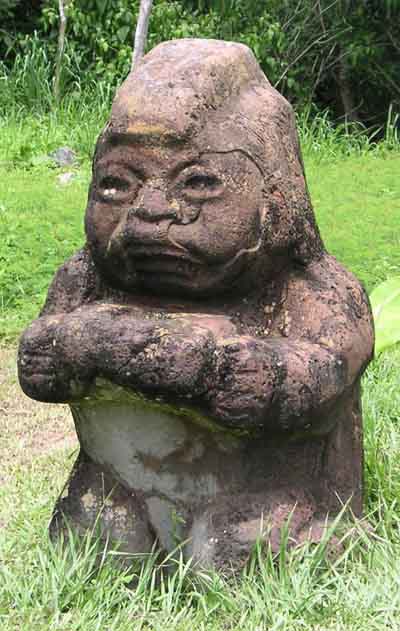
"The Grandmother", Monument 5 at La Venta
Monument 1, one of the four Olmec colossal heads at
Museo de Antropolog’a de Xalapa in Xalapa, Veracruz.
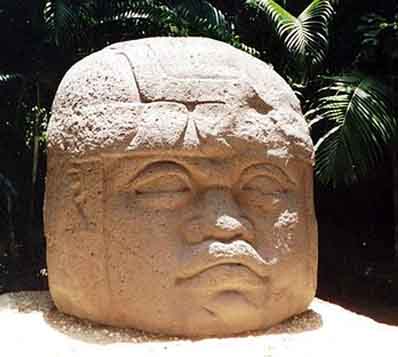
This head dates from 1200 to 900 BCE
and is 2.9 meters high and 2.1 meters wide.
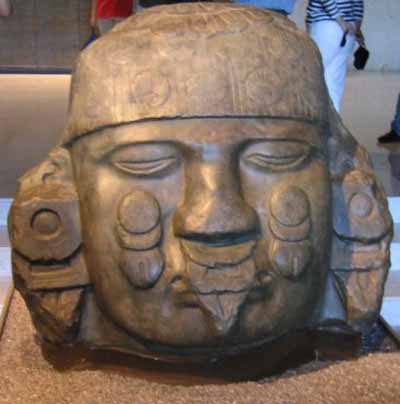
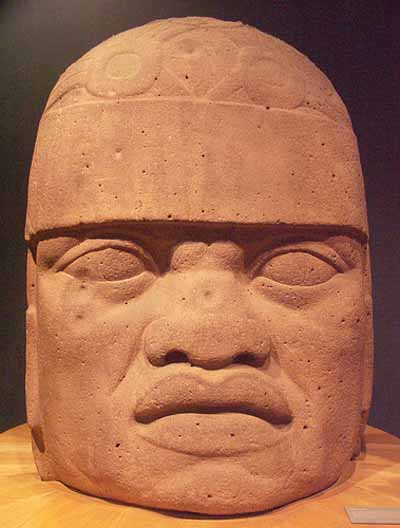
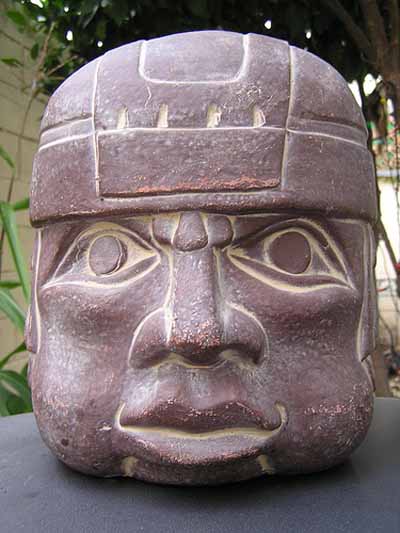
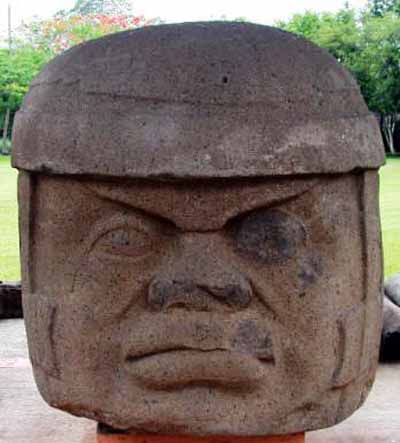
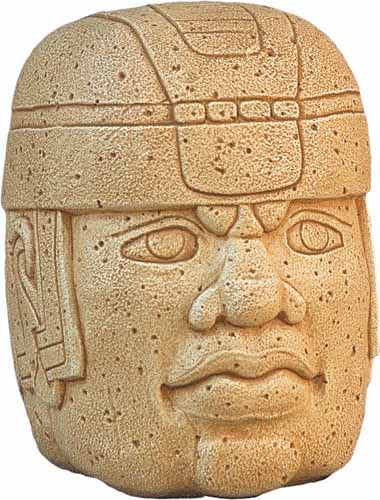
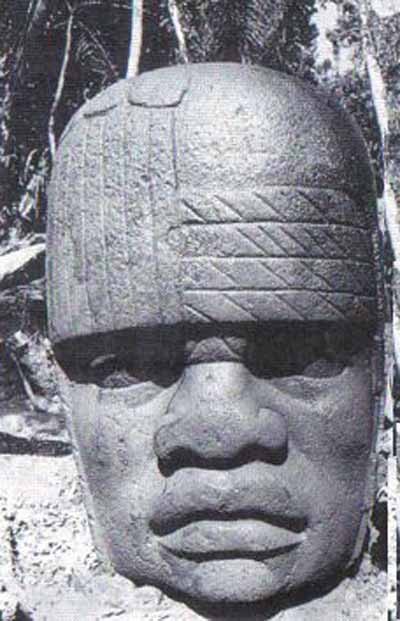
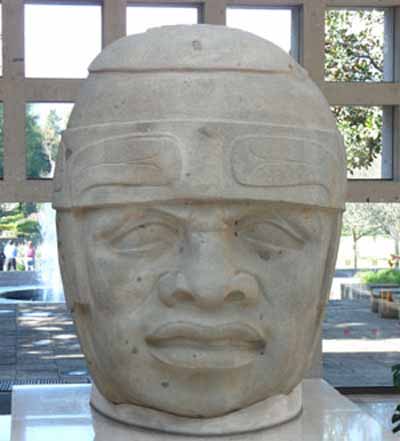
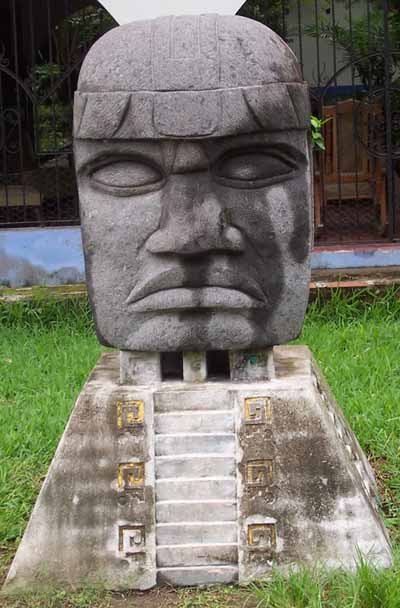
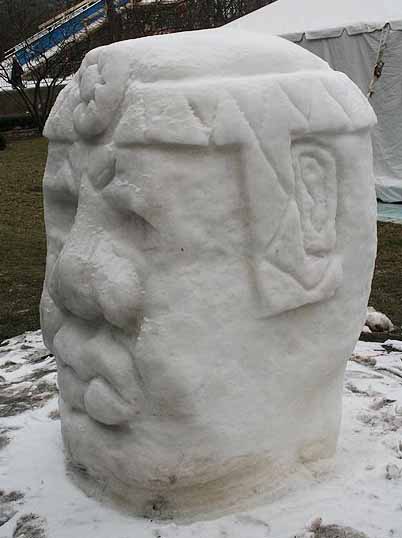
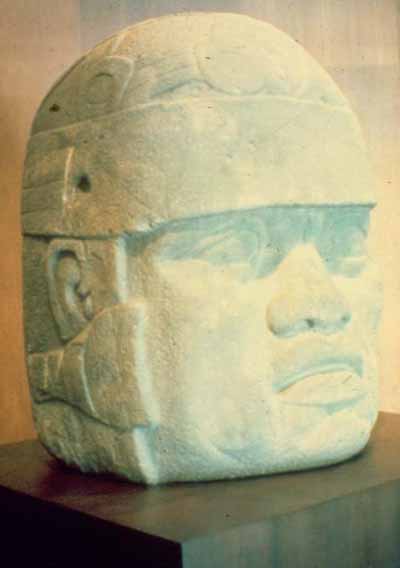
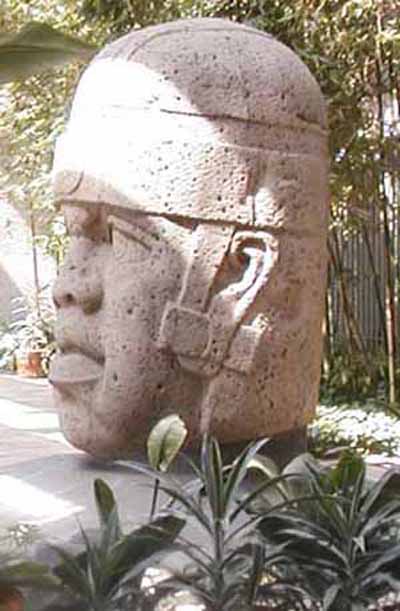
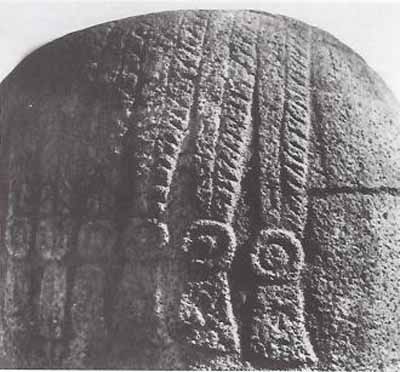
Monuments were also an important characteristic of Olmec centers. Today they provide us with some idea of the nature of Olmec ideology. The colossal heads are commanding portraits of individual Olmec rulers, and the large symbol displayed on the 'helmet' of each colossal head appears to be an identification motif for that person. Colossal heads glorified the rulers while they were alive, and commemorated them as revered ancestors after their death.
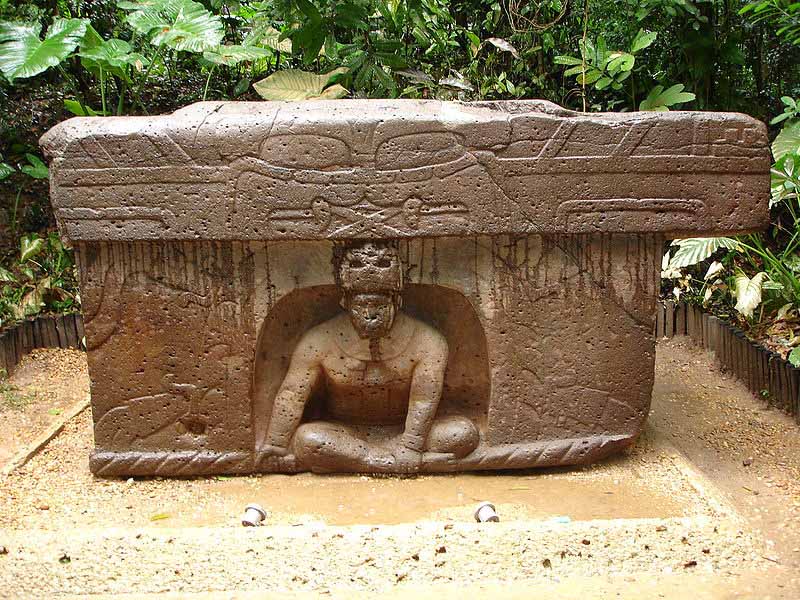
The inert were-jaguar baby held by the central figure is seen by some as an indication of child sacrifice.
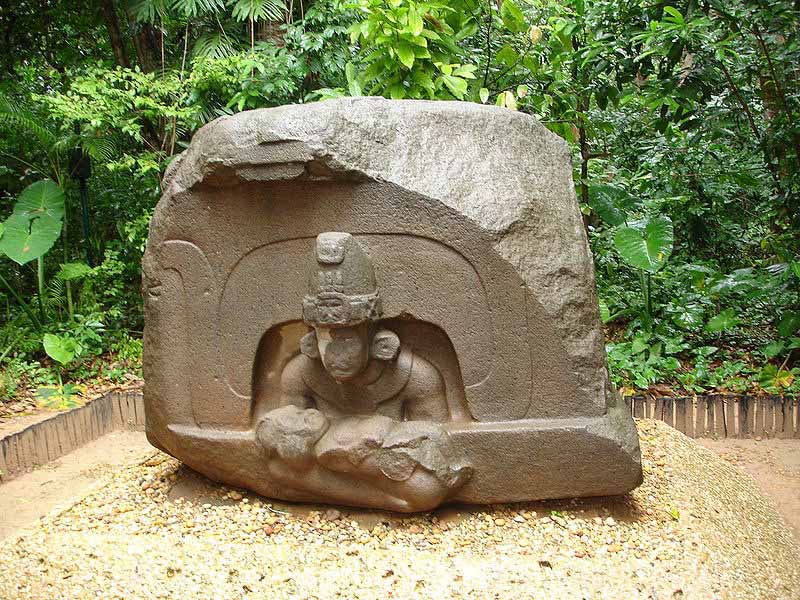
In contrast, its sides show bas-reliefs of humans holding quite lively were-jaguar babies.
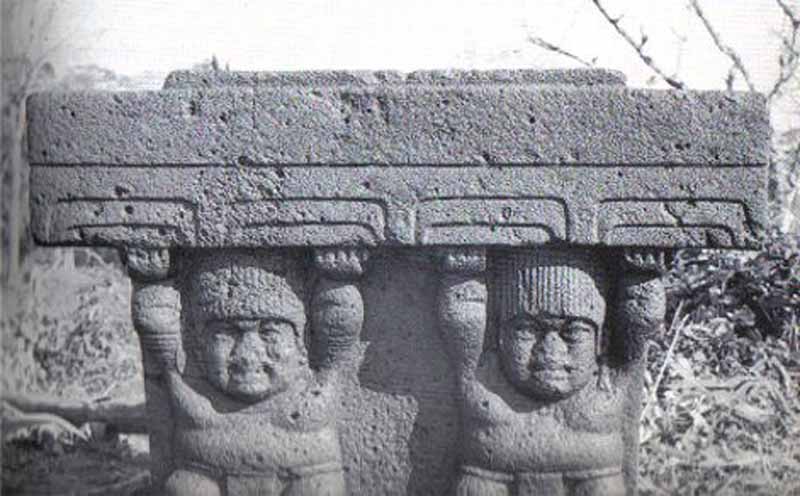
Altars were actually the thrones of Olmec rulers. The carving on the front of the throne shows the identified ruler sitting in a niche that symbolizes a cave entrance to the supernatural powers of the underworld. That scene communicated to the people their ruler's association with cosmological power
In addition to their influence with contemporaneous Mesoamerican cultures, as the first civilization in Mesoamerica, the Olmecs are credited, or speculatively credited, with many "firsts", including the bloodletting and perhaps human sacrifice, writing and epigraphy, and the invention of zero and the Mesoamerican calendar, and the Mesoamerican ballgame, as well as perhaps the compass. Some researchers, including artist and art historian Miguel Covarrubias, even postulate that the Olmecs formulated the forerunners of many of the later Mesoamerican deities.
Although there is no explicit representation of Olmec bloodletting in the archaeological record, there is nonetheless a strong case that the Olmecs ritually practiced it. Numerous natural and ceramic stingray spikes and maguey thorns, for example, have been found at Olmec sites, and certain artifacts have been identified as bloodletters.
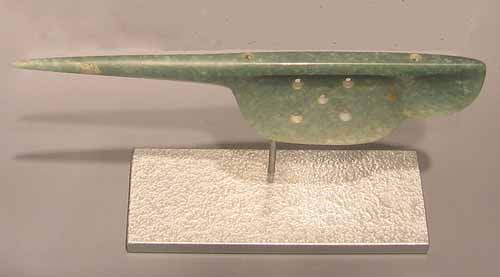
The argument that the Olmecs instituted human sacrifice is significantly more speculative. No Olmec or Olmec-influenced sacrificial artifacts have yet been discovered and there is no Olmec or Olmec-influenced artwork that unambiguously shows sacrificial victims (similar, for example, to the danzante figures of Monte Alban) or scenes of human sacrifice (such as can be seen in the famous ballcourt mural from El Tajin).
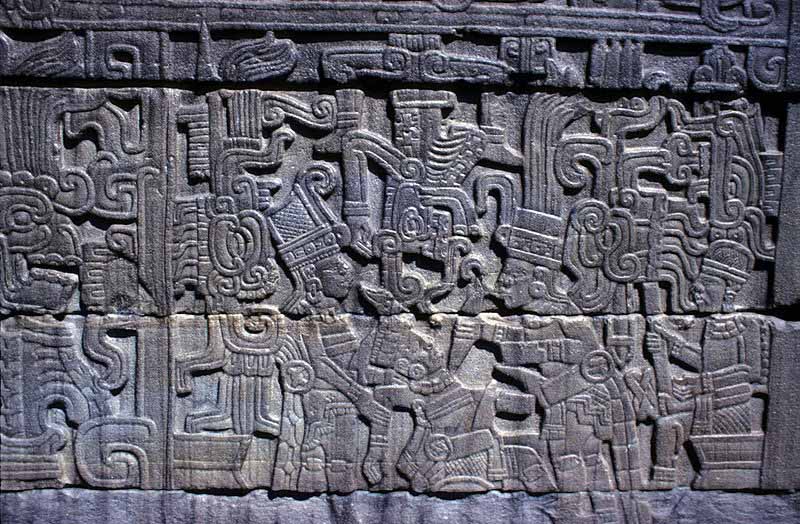
However, at the El Manati site, disarticulated skulls and femurs as well as complete skeletons of newborn or unborn children have been discovered amidst the other offerings, leading to speculation concerning infant sacrifice. It is not yet known, though, how the infants met their deaths. Some authors have also associated infant sacrifice with Olmec ritual art showing limp were-jaguar babies, most famously in La Venta's Altar 5 (to the left) or Las Limas figure. Any definitive answer will need to await further findings.
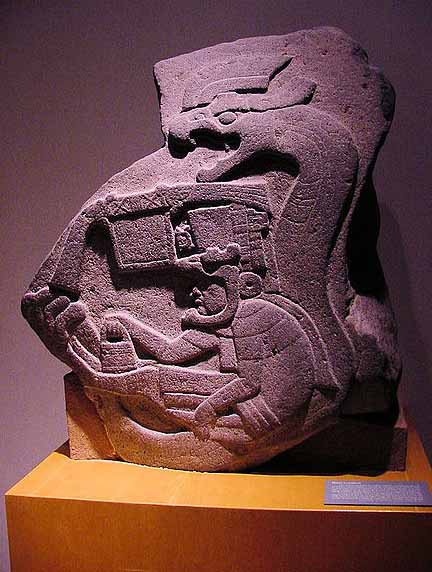
a feathered serpent in Mesoamerica.
It was formerly thought that the Olmec worshiped only one god, a rain deity depicted as a 'were-jaguar', but study has shown that there were at least 10 distinct gods represented in Olmec art. Present were several important deities of the later, established Meso-American pantheon, such as the fire god, rain god, corn/maize god, and the Feathered Serpent.
Olmec religious activities were performed by a combination of rulers, full-time priests, and shamans. The rulers seem to have been the most important religious figures, with their links to the Olmec deities or supernaturals providing legitimacy for their rule. There is also considerable evidence for shamans in the Olmec archaeological record, particularly in the so-called "transformation figures".
Olmec mythology has left no documents comparable to the Popul Vuh from Maya mythology, and therefore any exposition of Olmec mythology must rely on interpretations of surviving monumental and portable art and comparisons with other Mesoamerican mythologies. Olmec art shows that such deities as the Feathered Serpent and a rain supernatural were already in the Mesoamerican pantheon in Olmec times.
The feathered serpent can be found throughout Mesoamerican Mythology - also known as Quetzalcoatl, Kukulcan, Viracocha, among other gods played by the same soul in various guises. Pyramids of Mesoamerica
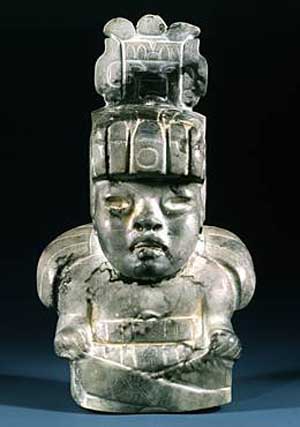
Divinely sanctioned authority derived from the intimate relationship between maize agriculture and the rituals performed to ensure its abundance. The earliest kings were portrayed wearing the regalia of the Maize God, embodying sacred power that guaranteed abundant crops. This richly dressed figure of an Olmec lord is one of the earliest such portrayals. Above his headband he wears the cleft mask of the Olmec Maize God.
The Man of Crops is a fertility figure in Mesoamerican mythology. Among the Olmec, gods are often depicted with a distinct cleft on the forehead, perhaps identifying this characteristic as divine. A carved celt from Veracruz shows a representation of God II, or the Maize God, growing corn from his cleft, and also shows this god with the snarling face associated with the jaguar (Coe 1972:3). He was a human man or boy who chose to give his life so that his people might grow food. The heroic Man of Crops is sometimes mentored or assisted by a god figure from the other world.
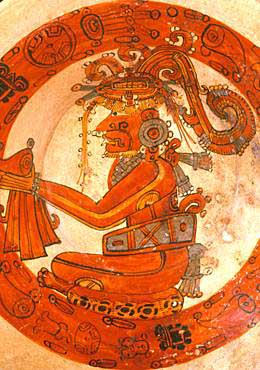
This king is dressed as the Maize God. He is seated cross-legged, in a rulership pose that goes back to the Olmec, and the foliated sign around his mouth may designate him as a lord or ruler. He holds an open bundle in his hands.
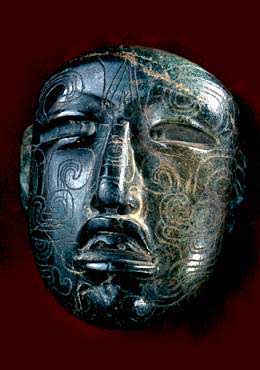
This incised maskette reveals an Olmec-style face covered with scrolled patterns on the cheek and a maize icon in the center of the forehead. Maize was a potent symbol of wealth for the Olmec.
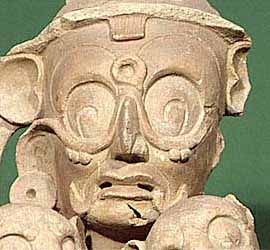
Some people believe that the principal deity was fundamentally an Earth god, though his power was not limited to terrestrial matters, and took the form of a jaguar. This God could have a water-earth persona. As a jaguar encompassing the forces of life or at least a dominance in its two strongest categories (with regards to Olmec life), water and earth. This deity supposedly had dominance over all things terrestrial and celestial. This God may have been half-jaguar, half-serpent, "were-jaguars". The jaguar represents the Earth Mother with the serpent representing the water, thus combining to represent life.
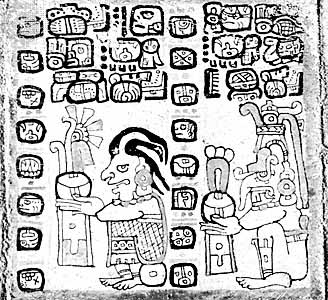
The Olmec image of the rain spirit appears frequently in the mythology of succeeding cultures. Invariably the rain spirit is male, though he may have a wife who shares authority over the waters. Often he is perceived as a child or a young man, sometimes as a dwarf. He may also be portrayed as a powerful rain god, with many helpers.
In Aztec and Maya traditions, the rain lord is a master spirit, attended by several helpers. His name in the Aztec language is Tlaloc, and his helpers are "tlaloque." The Maya of the Yucatan recognize Chaac and the "chacs." In the Guatemalan area, these spirits are often associated with gods of thunder and lightning as well as with rain. The rain spirits are known as Mam and the "mams" among the Mopan of Belize. In some traditions, as with the Pipil of El Salvador, the figure of the master is missing, and the myths focus on "rain children," or "rain boys." Modern Nahua consider these numerous spirits to be dwarfs, or "little people." In the state of Chiapas, the Zoque people report that the rain spirits are very old but look like boys.
The Olmecs are believed to be one of the first tribes to engage in Shamanistic rituals. The Olmec Tribe believed that the Jaquar was a rain deity and fertility diety. The Jaquar was chosen because the Olmecs believed it was the most powerful and feared animal. They also believed that the Jaquar was an Avatar of the living and the dead. The men would sacrifice blood to the jaguar, wear masks, dance, and crack whips to imitate the sound of thunder. This ritual was done in May. The Olmec also made offerings of jade figures to the jaguar. The Olmecs made numerous statues representing "Were, Jaquar " men. These men are normally shown with grimacing Jaquar facial features with Human bodies. They are believed to be men , of the Olmec tribe, that are transforming into the Jaquar. One of these transforming Shamans can be seen in the statue "Crouching figure of a Man-Jaquar".
It is an almost black, little figurine of a man rising from one knee in the ecstasy of transformation. The transformation figure shows the human and feline characteristics brilliantly fused together. The head and ears remain human, but the crown of it's head is smooth, as if shaved. The features of it's face seem to flow into each other and the eye sockets are wide and deeply bored. Extended by incised lines above the eyes, the carved eyebrows are similar to flame eyebrows and signify the shedding of skin.
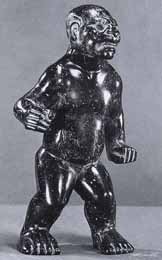
In the figurine the 'Standing figure of a Were-Jaquar' another Shaman is seen in the transformation process . This figure stands with one leg forward to counterbalance the slight torsion of the body. The arms are extended and each hand is balled into a fist, similar to a boxing stance. This Figure has almost the exact same features as the 'Crouching Figure' that represent the ecstasy of the transformation. Its hands and feet are oversized to anticipate the paws of the Jaquar.
In both figures the tortured facial features are intended to convey, not ferocity and aggressiveness, but emotional stress beyond endurance. It is precisely the sort of physically and mentally exhausting crisis, the crossing of the threshold between two worlds, to kinds of reality, if you will, that is part and practice of ecstatic Shamanism everywhere. The crossing over and transformation into the most powerful predator of the rain forest and the Savannah.
The Transformation was brought on by a series of activities which could incorporate singing or chanting to the Jaguar deity. The Shaman would dance around and chant a mantra to spirit world and would also use the rhythm of a beating. It is also believed that the Olmec would also ingest a 'mind altering' drug which would intoxicate the Shaman and make him dizzy Tobacco powder , which was also used to achieve the transformation could be inhaled directly through the nose or ground up with lime to make a chewing wad. The evidence to support this can be seen in the Hollow Figure in this statue a man is seen using a snuffing pipe made from small gourds.
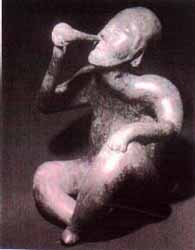
The "were-jaguar " Shamans were also associated and depicted in acrobatic poses, this represents the agility of the feline. Shamans were believed to have the ability to flip backwards and transform before they had landed. There have been a number a figures found , that incorporate acrobatic poses. In the statues 'Figure with feet on head' and "vessel in the form of a contortionist". Shamans are shown in complex and complicated poses. The Shamans seems to very comfortable and achieve each pose with ease.
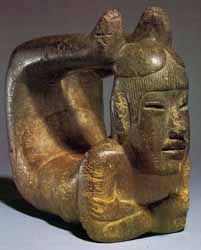
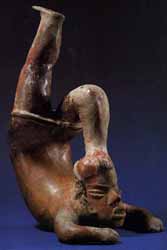
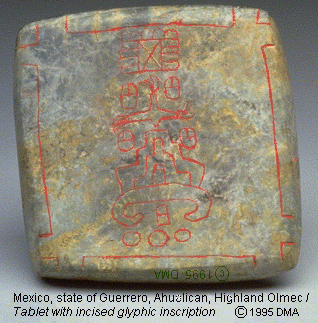
Olmec Glyph 900-500 BC: Dallas Museum
About 3,000 years ago, elders and leaders in farming communities of Mesoamerica established a shared vision of their world. These sages of Olmec civilization etched their creed on polished stone artifacts and then rubbed red paint into the patterns. This is a code that could be read by any sage who knew the religion. This plaque reords the story of creation. It shows the World Tree sprouting out of Creation Mountain at the Three-Stone-Place the center of the night sky, the renewed sky, the mountian and the renewed earth, and the Three-Stone-Place the hearth, the place of First Father's rebirth as Maize.
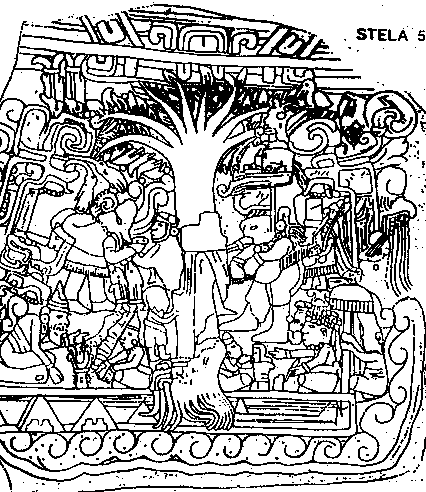
It confirms the tradition recorded by:
Famous Mayan historian Ixtlixochitl, that the Olmec came to Mexico in "ships of barks " and landed at Pontochan, which they commenced to populate
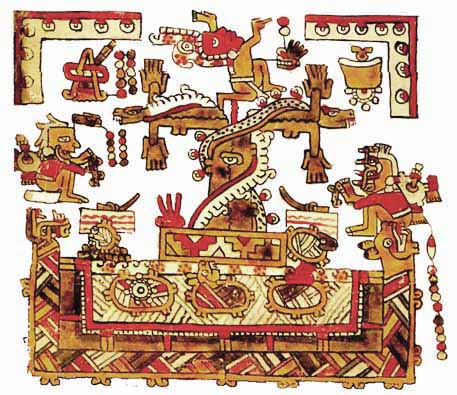
The Eye of Creation and the Snake or Human DNA
The Olmec may have been the first civilization in the Western Hemisphere to develop a writing system. Symbols found in 2002 and 2006 date to 650 BCE and 900 BCE respectively, preceding the oldest Zapotec writing dated to about 500 BCE.
The 2002 find at the San Andres site shows a bird, speech scrolls, and glyphs that are similar to the later Mayan hieroglyphs. Known as the Cascajal Block, the 2006 find from a site near San Lorenzo, shows a set of 62 symbols, 28 of which are unique, carved on a serpentine block. A large number of prominent archaeologists have hailed this find as the "earliest pre-Columbian writing". Others are skeptical because of the stone's singularity, the fact that it had been removed from any archaeological context, and because it bears no apparent resemblance to any other Mesoamerican writing system.
There are also well-documented later hieroglyphs known as "Epi-Olmec," and while there are some who believe that Epi-Olmec may represent a transitional script between an earlier Olmec writing system and Mayan writing, the matter remains unsettled.
The Olmecs were clever mathematicians and astronomers who made accurate calendars.
The back of Stela C from Tres Zapotes
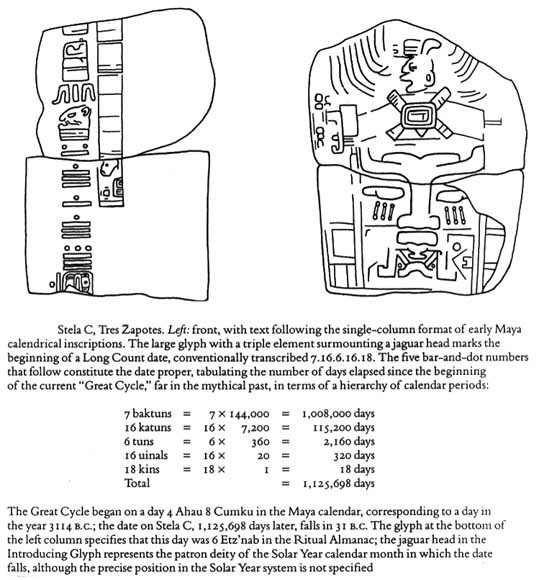
This is the second oldest Long Count date yet discovered. The numerals 7.16.6.16.18 translate to September 3, 32 BCE (Julian). The glyphs surrounding the date are one of the few surviving examples of Epi-Olmec script. This is one of the earliest uses of the zero concept in history.
The Long Count calendar used by many subsequent Mesoamerican civilizations, as well as the concept of zero, may have been devised by the Olmecs. Because the six artifacts with the earliest Long Count calendar dates were all discovered outside the immediate Maya homeland, it is likely that this calendar predated the Maya and was possibly the invention of the Olmecs. Three of these six artifacts were found within the Olmec heartland. But an argument against an Olmec origin is the fact that the Olmec civilization had ended by the 4th century BCE, several centuries before the earliest known Long Count date artifact.
The Epi-Olmec who unhabited the same land, and were probably descended at least in part from the Olmec, seem to have been the earliest users of the 'bar and dot' system of recording time.
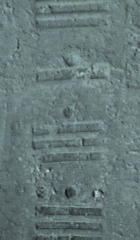
The low relief on this stone shows the detail from a four-digit numerical recording, read as 15.6.16.18. The vigesimal (or base-20) counting system has been used across Mesoamerica. A value of 5 is represented by a bar, and a value of 1 is represented by a dot, such that the three bars and single dot here stands for 16. The Maya would later adopt this counting system for their Long Count calendar.
The Olmec, whose name means "rubber people" in the Nahuatl language of the Aztecs, are strong candidates for originating the Mesoamerican ballgame so prevalent among later cultures of the region and used for recreational and religious purposes. A dozen rubber balls dating to 1600 BCE or earlier have been found in El Manati, an Olmec sacrificial bog 10 kilometres east of San Lorenzo Tenochtitlan. These balls predate the earliest ballcourt yet discovered at Paso de la Amada, circa 1400 BCE, although there is no certainty that they were used in the ballgame.
While the actual ethno-linguistic affiliation of the Olmec remain unknown, various hypotheses have been put forward. For example, in 1968 Michael D. Coe speculated that the Olmec were Mayan predecessors.
In 1976 linguists Lyle Campbell and Terrence Kaufman published a paper in which they argued a core number of loanwords had apparently spread from a Mixe-Zoquean language into many other Mesoamerican languages.
Campbell and Kaufman proposed that the presence of these core loanwords indicated that the Olmec generally regarded as the first "highly civilized" Mesoamerican society - spoke a language ancestral to Mixe-Zoquean. The spread of this vocabulary particular to their culture accompanied the diffusion of other Olmec cultural and artistic traits that appears in the archaeological record of other Mesoamerican societies.
Mixe-Zoque specialist Soren Wichmann first critiqued this theory on the basis that most of the Mixe-Zoquean loans seemed to originate from the Zoquean branch of the family only. This implied the loanword transmission occurred in the period after the two branches of the language family split, placing the time of the borrowings outside of the Olmec period. However new evidence has pushed back the proposed date for the split of Mixean and Zoquean languages to a period within the Olmec era.
Based on this dating, the architectural and archaeological patterns and the particulars of the vocabulary loaned to other Mesoamerican languages from Mixe-Zoquean, Wichmann now suggests that the Olmecs of San Lorenzo spoke proto-Mixe and the Olmecs of La Venta spoke proto-Zoque.
At least the fact that the Mixe-Zoquean languages still are, and are historically known to have been, spoken in an area corresponding roughly to the Olmec heartland, leads most scholars to assume that the Olmec spoke one or more Mixe-Zoquean languages.
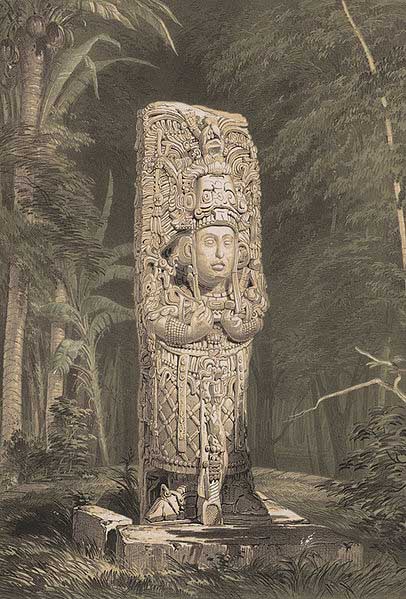
Little is directly known about the societal or political structure of Olmec society. Although it is assumed by most researchers that the colossal heads and several other sculptures represent rulers, nothing has been found like the Maya stelae which name specific rulers and provide the dates of their rule.
Instead, archaeologists relied on the data that they had, such as large- and small-scale site surveys. These provided evidence of considerable centralization within the Olmec region, first at San Lorenzo and then at La Venta - no other Olmec sites come close to these in terms of area or in the quantity and quality of architecture and sculpture.
This evidence of geographic and demographic centralization leads archaeologists to propose that Olmec society itself was hierarchial, concentrated first at San Lorenzo and then at La Venta, with an elite that was able to use their control over materials such as water and monumental stone to exert command and legitimize their regime.
Nonetheless, Olmec society is thought to lack many of the institutions of later civilizations, such as a standing army or priestly caste. And there is no evidence that San Lorenzo or La Venta controlled, even during their heyday, all of the Olmec heartland. There is some doubt, for example, that La Venta controlled even Arroyo Sonso, only some 35 km away. Studies of the Tuxtla Mountain settlements, some 60 km away, indicate that this area was composed of more or less egalitarian communities outside the control of lowland centers.
The wide diffusion of Olmec artifacts and "Olmecoid" iconography throughout much of Mesoamerica indicates the existence of extensive long-distance trade networks. Exotic, prestigious and high-value materials such as greenstone and marine shell were moved in significant quantities across large distances. While the Olmec were not the first in Mesoamerica to organise long-distance exchanges of goods, the Olmec period saw a significant expansion in interregional trade routes, more variety in material goods exchanged and a greater diversity in the sources from which the base materials were obtained.
Despite their size, San Lorenzo and La Venta were largely ceremonial centers, and the majority of the Olmec lived in villages similar to present-day villages and hamlets in Tabasco and Veracruz.
These villages were located on higher ground and consisted of several scattered houses. A modest temple may have been associated with the larger villages. The individual dwellings would consist of a house, an associated lean-to, and one or more storage pits (similar in function to a root cellar). A nearby garden was used for medicinal and cooking herbs and for smaller crops such as the domesticated sunflower. Fruit trees, such as avocado or cacao, were likely available nearby.
Although the river banks were used to plant crops between flooding periods, the Olmecs also likely practiced swidden (or slash-and-burn) agriculture to clear the forests and shrubs, and to provide new fields once the old fields were exhausted.
Fields were located outside the village, and were used for maize, beans, squash, manioc, sweet potato, as well as cotton. Based on archaeological studies of two villages in the Tuxtlas Mountains, it is known that maize cultivation became increasingly important to the Olmec over time, although the diet remained fairly diverse.
The fruits and vegetables were supplemented with fish, turtle, snake, and mollusks from the nearby rivers, and crabs and shellfish in the coastal areas. Birds were available as food sources, as were game including peccary, opossum, raccoon, rabbit, and in particular deer. Despite the wide range of hunting and fishing available, midden surveys in San Lorenzo have found that the domesticated dog was the single most plentiful source of animal protein.
The name "Olmec" means "rubber people" in Nahuatl, the language of the Aztec, and was the Aztec name for the people who lived in the Gulf Lowlands in the 15th and 16th centuries, some 2000 years after the Olmec culture died out. The term "rubber people" refers to the ancient practice, spanning from ancient Olmecs to Aztecs, of extracting latex from Castilla elastica, a rubber tree in the area. The juice of a local vine, Ipomoea alba, was then mixed with this latex to create rubber as early as 1600 BCE.
Early modern explorers and archaeologists, however, mistakenly applied the name "Olmec" to the rediscovered ruins and artifacts in the heartland decades before it was understood that these were not created by people the Aztecs knew as the "Olmec", but rather a culture that was 2000 years older. Despite the mistaken identity, the name has stuck.
It is not known what name the ancient Olmec used for themselves; some later Mesoamerican accounts seem to refer to the ancient Olmec as "Tamoanchan". A contemporary term sometimes used to describe the Olmec culture is tenocelome, meaning "mouth of the jaguar".
Olmec culture was unknown to historians until the mid-19th century. In 1869 the Mexican antiquarian traveller Josˇ Melgar y Serrano published a description of the first Olmec monument to have been found in situ. This monument - the colossal head now labelled Tres Zapotes Monument A - had been discovered in the late 1850s by a farm worker clearing forested land on a hacienda in Veracruz.
Hearing about the curious find while traveling through the region, Melgar y Serrano first visited the site in 1862 to see for himself and complete partially exposed sculpture's excavation. His description of the object, published several years later after further visits to the site, represents the earliest documented report of an artifact of what is now known as the Olmec culture.
In the latter half of the 19th century, Olmec artifacts such as the Kunz Axe (right) came to light and were subsequently recognized as belonging to a unique artistic tradition.
Frans Blom and Oliver La Farge made the first detailed descriptions of La Venta and San Martin Pajapan Monument 1 during their 1925 expedition. However, at this time most archaeologists assumed the Olmec were contemporaneous with the Maya - even Blom and La Farge were, in their own words, "inclined to ascribe them to the Maya culture".
Matthew Stirling of the Smithsonian Institution conducted the first detailed scientific excavations of Olmec sites in the 1930s and 1940s. Stirling, along with art historian Miguel Covarrubias, became convinced that the Olmec predated most other known Mesoamerican civilizations.
In counterpoint to Stirling, Covarrubias, and Alfonso Caso, however, Mayanists Eric Thompson and Sylvanus Morley argued for Classic-era dates for the Olmec artifacts. The question of Olmec chronology came to a head at a 1942 Tuxtla Gutierrez conference, where Alfonso Caso declared that the Olmecs were the "mother culture" ("cultura madre") of Mesoamerica.
Shortly after the conference, radiocarbon dating proved the antiquity of the Olmec civilization, although the "mother culture" question generates much debate even 60 years later.
ANCIENT AND LOST CIVILIZATIONS